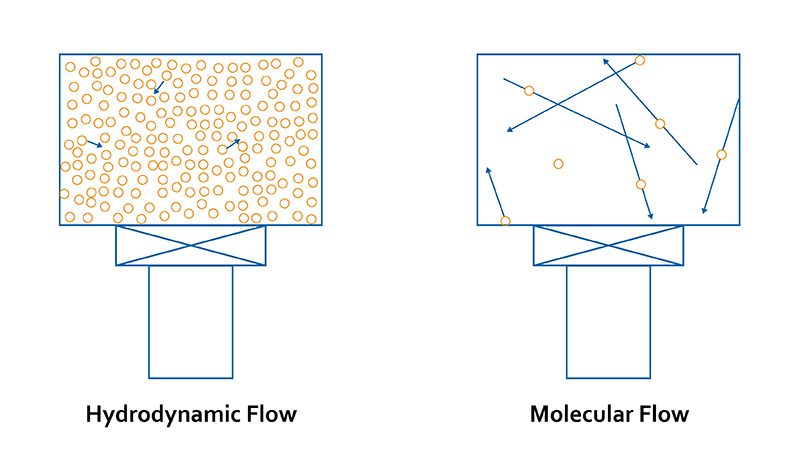
Posted on
Physical vapor deposition (PVD) and other types of thin film deposition require a vacuum chamber to create thin film coatings. A vacuum is created when the coating chamber is pumped down, and all of the air molecules and other gasses are evacuated from the system. If these molecules are not reduced to an acceptable level, it will lower the thin film’s quality and durability. What is “acceptable” is entirely dependent on what you are trying to deposit.
First, a mechanical pump, operating in the hydrodynamic flow regime, evacuates almost all of the air molecules, until the pressure is low enough to enter the molecular flow regime. At that point, the high vacuum pump then removes the remaining vapors. There are several types of high vacuum pumping options, with varying benefits depending on your specific system needs.
Key Considerations for Selecting a Pump
There are five primary factors you need to consider when it comes to selecting a high vacuum pump for thin film deposition:
- Cleanliness: Cleanliness is one of the most important factors related to performance. Without it, the pump could cause a build-up of contaminants in your system, such as oil, which affects reliability and thin film quality.
- Air pumping speed: This refers to how fast the pump can pump down the chamber and completely remove all air and gas molecules. Typically, a faster pumping speed means that the pump type can support a higher throughput for production, because it doesn’t take as long to pump down. This is particularly important in batch systems that are pumped down from atmosphere with every run.
- Water pumping speed: When the chamber is being pumped down, outgassing occurs, with water molecules coming off of the walls and crevices of the system. These water molecules need to be pumped out just as efficiently as the gas molecules. Your water pumping speed dictates the lowest pressure you can achieve in a high vacuum system. Note that there are different considerations and concerns for ultimate vacuum in an ultra-high vacuum system.
- Preventative maintenance cycle: You’ll need to think about how often your pump will require preventative maintenance, and if these service interruptions are going to greatly affect your manufacturing capabilities. A frequent PM cycle may be worth it if the performance benefits are there, but it will also lower your system uptime. If your application requires a high factory output, you may not be able to make that tradeoff.
- Cost: The initial cost of investment is important to consider, but so are other key factors like cost of ownership and ROI. If your cost of ownership will be significantly lower for your overall system and application-specific needs, you’ll want to strongly consider that pumping option, instead of just focusing on the up-front cost to purchase.
Pumping Types
There are three main types of pumps for physical vapor deposition: cryogenic, turbomolecular and diffusion. All three have their own benefits and drawbacks, and the type of pump you select will depend largely on your specific process requirements based on the considerations above.
- Cryogenic pumps: This type of system works by trapping molecules such as water vapor, gaseous material, oil and other substances onto the pump’s cold surfaces, effectively freezing them out of the vacuum chamber. Cryogenic pumps can achieve the best vacuum levels and pressures, making them the best option for pumping water quickly. They are, however, the most expensive type of pumps and require a frequent PM cycle.
- Turbomolecular pumps: A turbo pump uses a fan rotor to collide with gas molecules from the chamber and towards the pump’s exhaust in order to create a vacuum inside the system. This type of pump has a very fast pumping speed, and they’re very reliable, so they don’t require a frequent PM cycle. It’s also the preferred pumping type for reactive processes. Turbomolecular pumps are not the best option for pumping water molecules, so if that’s a critical process need, it’s best to consider a different pumping type. They do not typically provide as low a vacuum level as a cryo pump, but are considerably less expensive. The base vacuum level can be improved by adding a water pump, but that negates the cost advantage.
- Diffusion pumps: A diffusion pump works by heating and boiling oil, then compressing the oil vapor through a cone so that it escapes in “jets” as it moves up. The oil vapor then collides with air molecules inside the chamber and traps them to the pump’s walls. Diffusion pumps are typically the cheapest type, and they’re a good option for pumping helium or hydrogen. They tend to leave oil inside the system, so cleanliness is a major drawback.
For specific questions on high vacuum pumping types and considerations, contact the Denton team.